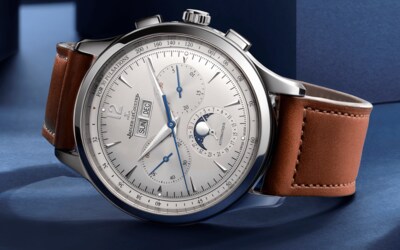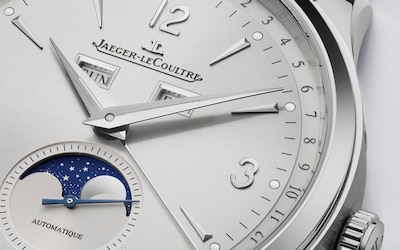The Calibre Complete Guide To Jaeger-LeCoultre
By Sarah Jayne Potter | 7 minute read

Jaeger-LeCoultre is not only an embodiment of luxury, but is behind some of the Swiss watch industry’s most iconic innovations. From the avant-garde Atmos clock that runs perpetually without human intervention, to the revered Reverso that is one of their many feats of engineering.
Those who wear a Jaeger-LeCoultre are in good company, as the title of icon extends to the maison’s clientele too. Her Majesty Queen Elizabeth II, Amelia Earhart, Charlie Chaplin, Leonardo Di Caprio, and Jay Z are among the many that have had a Jaeger-LeCoultre timepiece adorn their wrist. The brand has transcended time and trends to remain an example of what happens when technique meets art.
Jaeger-LeCoultre’s story begins in the 1800s. Surrounded by the alluring Swiss mountains, here a young boy honed his skills in the art of watchmaking through a delicate balance of intellect and imagination. That boy was Antoine LeCoultre, who’s ambition to continually innovate propelled the maison into its iconic status, as one of the world’s leading Swiss luxury watch and clock manufacturers.
Nowadays, you’ll find the heart of Jaeger-LeCoultre within a peaceful Swiss valley, lost amongst pine trees and dusted in snow. This is the Vallée de Joux in the Swiss Jura Mountains, home to Jaeger-LeCoultre Manufacture and where over 1,000 watchmakers come to continue LeCoultre’s legacy of fine watchmaking.
From design and assembly to decoration, one hundred and eighty different expert skills work alongside one another here. Each small step essential in bringing the timepieces to life. And such meticulous dedication shows, with more than 1,200 calibres having been created by the teams since 1833.

In this guide to Jaeger-LeCoultre we explore the story behind the maison, its iconic collections, and our team’s favoured timepieces.
The story of Jaeger-LeCoultre
Antoine LeCoultre was an inventor by nature. Boundless curiosity led him to transform his family’s small barn into a watchmaking atelier, and here he invented a machine to cut watch pinions. Following its success, he went on to found a small workshop in Le Sentier and continued his education in horology.
This led to the invention of the Millionometre in 1844, the world’s first instrument capable of measuring the micron. Such innovation allowed for meticulous construction of watch parts and won LeCoultre a gold medal in timepiece precision at London’s first Universal Exhibition. Interestingly, the Millionometre was never patented but its rare and complex composition remained a closely kept secret for over fifty years.
During this era, it was commonplace for watchmakers with specific skills to be scattered across various locations and within hundreds of different workshops. In 1866, Antoine and his son Elie set about revolutionising this way of working, by founding the very first manufacturing location that housed all employees, and their expertise, under one roof. Officially called LeCoultre & Cie, the company employed over 500 people and guided the development of the first partially mechanised production process for complicated movements.
By 1900, LeCoultre & Cie had created over 350 different calibres, 128 of which came with chronograph functions. LeCoultre’s masterful vision, alongside the prestigious company he was building, was evident and for the next 30 years the Grande Maison of the Vallée de Joux was home to the production of the majority of movement blanks for Patek Philippe.
By 1903, Edmond Jaeger, watchmaker to the French Navy, had invented ultra-thin movements and put out a call to arms for watchmakers to develop and produce them. With innovation innate in the LeCoultre family, Antoine’s grandson Jacques-David took on Jaeger’s challenge and ended up creating a collection of ultra-thin pocket watches, including the thinnest in the world that featured a LeCoultre Calibre 145. This was the beginning of a beautiful collaboration.
At the same time, French jeweller Cartier signed a contract stating that all of Jaeger’s movements would be exclusive to them for fifteen years. The movements were of course produced by LeCoultre. Similarly, upon acquiring the patent for the atmospherically powered Atmos clock, Jaeger licensed it to LeCoultre for use in France and Switzerland. Such high-profile collaborations between the two names led to the company being officially renamed as Jaeger-LeCoultre in 1937.
From here, the legendary watchmaker as we know it today was founded and the rest, as they say, is history. However, the story doesn’t end there. The entrepreneurial spirit of both LeCoultre and Jaeger lives on today, seen in the ingenuity of their master watchmakers and satisfaction of loyal clients. Together, this has earned the maison its rightful renown in the watchmaking industry.

Reverso
When polo-playing British Army officers in India presented watch dealer César de Trey with a unique challenge, he turned to Jacques-David LeCoultre and his engineer René-Alfred Chauvot. The need to create a watch that could withstand the on-horseback bounces and knocks of gentlemens’ mallets during a match, led to the creation of the Reverso.
Chauvot designed a reversible case that was able to protect the crystal and dial by sliding outwards and swivelling around, with the plain caseback now facing forward. Launched in 1931 and with a name inspired by the Latin for ‘I turn around’, the Reverso quickly became admired for its trademarked Art Déco aesthetic and remains a sought-after timepiece to this day.
Calibre 101
Owing to its impossibly small stature, the Calibre 101 is a feat of meticulous craftsmanship. Despite weighing approximately one gram and being 14mm long and less than 5mm wide, it features 98 parts. This hand-wound calibre is the smallest mechanical movement in the world.
Introduced in 1929 and originally developed for jewellery watches, the models that feature the Calibre 101 are as exquisite in design as they are impressive. Sweeping curves and spectacular diamond flourishes pay homage to the delicate nature of what’s inside, while epitomising the very essence of luxury. In fact, the Calibre 101 outdid itself in terms of achievements by powering the wristwatch of choice for Her Majesty Queen Elizabeth II, who wore it on her coronation day in 1952.

Atmos
Epitomising both the artistry and technical complexities of clockmaking, the Atmos is an impressive piece of manufacturing. Drawing energy from temperature and atmospheric pressure changes in the environment means the Atmos timepiece can run for years, without the need for human intervention.
Invented in 1928 by Swiss engineer Jean-Léon Reutter, the patents were purchased by LeCoultre & Cie, and the maison spent a subsequent ten years developing and perfecting the clock and its intricacies before manufacturing it.
The nation is so proud of this innovation, that Atmos clocks have been the official gift of the Swiss Confederation since 1950, and adorn the mantle pieces of presidents and world officials the globe over.
Memovox
The 1950s saw Jaeger-LeCoultre perfect its mastery of chiming mechanisms to create the Memovox. Meaning ‘the voice of memory’, the watch resonates with many solely for its refined alarm complications.
The world’s first self-winding alarm came in 1956, courtesy of a Jaeger-LeCoultre Calibre 815. Then in 1959, the Memovox Deep Sea was created specifically for divers, alerting them to when they needed to begin their ascension. The innovation of the Memovox continues to this day, with new complications – such as timers and 24-hour time zone displays – being included.

Master Collection
The Master Collection is one of Jaeger-LeCoultre’s best-selling collections. An elegant detour from embellishment and stylistic flourishes, these timepieces focus on the very essence of what a watch is; focusing on refined reliability and pure form.
Since its inception, the Master Collection has been divided into numerous family lines, the most notable of which are the Jaeger-LeCoultre Master Grande Tradition, the Jaeger-LeCoultre Master Ultra Thin, and the Jaeger-LeCoultre Master Control. The latter often being considered highly sought-after thanks to its observation of classic design and craftsmanship.
Rendez-Vous
True to the innovative nature of the brand, Jaeger-LeCoultre were one of the first watchmakers to create luxurious and sophisticated timepieces for women. The Rendez-Vous collection is a tribute to such elegance.
This collection revels in the complex, with an incredibly small automatic calibre, and such intricacy is paired with artistry owing to the diamonds and precious stones used as finishing flourishes. In fact, the use of opulent materials even extends to the threads that are used to secure the stone. These are fine gold and truly affirm the elegant status of this collection.
Our Buyer’s Highlights
“The Reverso needs no introduction and is an iconic unique timepiece for any collection. Originally designed for Polo players, Jaeger LeCoultre continuously expand the collection with different features. Whether you pick a Reverso with a different dial on the reverse or the iconic plain case back, a Reverso is a must have.”
“The sleek lines and discreet technicality of a Polaris create the effortless harmony that is ideal for those looking to combine elegance with thrill seeking. A modern approach with enough vintage nostalgia to make this the ultimate timepiece for any collection.“
“Ultra-Thin is one of our bestselling Jaeger LeCoultre families and any piece is a must have for any watch collection. The understated elegance of the simple dial is lifted with a moonphase complication which completely captivates the eye every time you check the time. A sure conversation starter for any watch enthusiast.”
To ensure your Jaeger-LeCoultre watch stays in exquisite condition, take a look at the tips for taking care of your luxury timepiece, or find out more about our At Your Service collection.